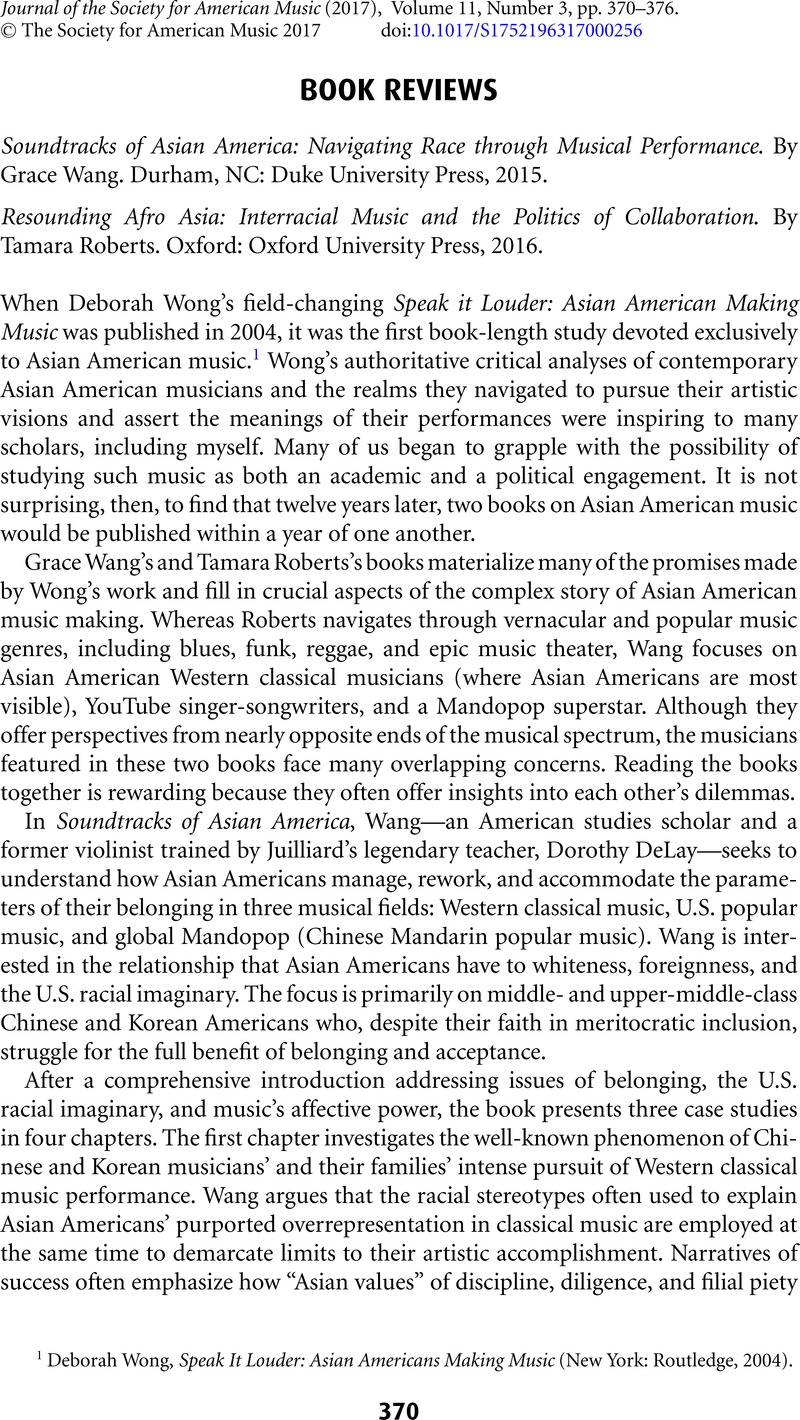No CrossRef data available.
Article contents
Soundtracks of Asian America: Navigating Race through Musical Performance. By Grace Wang . Durham, NC: Duke University Press, 2015. - Resounding Afro Asia: Interracial Music and the Politics of Collaboration. By Tamara Roberts . Oxford: Oxford University Press, 2016.
Published online by Cambridge University Press: 23 August 2017
Abstract

- Type
- Book Review
- Information
- Copyright
- Copyright © The Society for American Music 2017
References
1 Wong, Deborah, Speak It Louder: Asian Americans Making Music (New York: Routledge, 2004)Google Scholar.
2 Hung, Eric, “Performing ‘Chineseness’ on the Western Concert Stage: The Case of Lang Lang,” Asian Music 40, no. 1 (2009): 131–48Google Scholar; Ee Tan, Shzr, “New Chinese Masculinities on the Piano: Lang Lang and Li Yundi,” in Gender in Chinese Music, ed. Harris, Rachel and Pease, Rowan (New York: University of Rochester Press, 2013), 132–51Google Scholar; Yang, Mina, Planet Beethoven: Classical Music at the Turn of the Millennium (Hanover, NH: Wesleyan University Press, 2014), 110–17Google Scholar, quotation on 117.
3 Wong, Speak It Louder, 107.
4 One exception is a section where she incorporates Tamara Roberts's discussion of racialized genres, styles, and categories (131–32).
5 Grace Wang cites W. Anthony Sheppard, “Global Exoticism and Modernity: The Case of ‘Chinked-Out’ Music” (paper presented at the Asian Popular Music Conference, Princeton University, March 2011). Sheppard presents the argument about self-orientalization fully later on. See Anthony Sheppard, W., “Global Exoticism and Modernity,” in The Cambridge History of World Music, ed. Bohlman, Philip (Cambridge: Cambridge University Press, 2013), 606–33CrossRefGoogle Scholar.
6 Roberts's analyses of three types of interracial collaboration are more productive than the model of sonic-racial triangulation to which she frequently returns to discuss racial politics. It is a geometric model for understanding the positioning of sonorities associated with whiteness, blackness, and Asianness along axes of superior/inferior (vertical hierarchy of status) and insider/foreigner (horizontal array of belongingness).
7 My summary here points to the potential of Roberts's category by drawing a stronger connection to the posthuman theory of feminist Karen Barad. With the notion of intra-activity, Barad draws attention to the ontological inseparability of the “parties” of phenomena. Barad, Karen, Meeting the Universe Halfway: Quantum Physics and the Entanglement of Matter and Meaning (Durham, NC: Duke University. Press, 2007), 393.CrossRefGoogle Scholar
8 In his excellent analysis of “Chee-Lai,” Jean, Richard So describes such vision as “fantasy.” See his Transpacific Community: America, China, and the Rise and Fall of a Global Cultural Network (New York: Columbia University Press, 2016), 109.Google Scholar
9 Lee, Erika, The Making of Asian America (New York: Simon & Shuster, 2015), 10 Google Scholar.




